Feifei Zhai
CROP: Contextual Region-Oriented Visual Token Pruning
May 27, 2025Abstract:Current VLM-based VQA methods often process entire images, leading to excessive visual tokens that include redundant information irrelevant to the posed question. This abundance of unnecessary image details creates numerous visual tokens, drastically increasing memory and computational requirements in VLMs. To address this, we propose Contextual Region-Oriented Visual Token Pruning (CROP), a novel framework to compress visual tokens through a two-step process: Localization and Pruning. Specifically, CROP first employs an efficient model to identify the contextual region relevant to the input query. Subsequently, two distinct strategies are introduced for pruning: (1) Pre-LLM Compression (PLC), which adaptively compresses different image regions with varying ratios, and (2) Inner-LLM Pruning (ILP), a training-free method that prunes tokens within early LLM layers guided by the identified contextual region. Extensive experiments on a wide range of VQA tasks demonstrate that CROP significantly outperforms existing visual token pruning methods and achieves state-of-the-art performance. Our code and datasets will be made available.
What are they talking about? Benchmarking Large Language Models for Knowledge-Grounded Discussion Summarization
May 18, 2025Abstract:In this work, we investigate the performance of LLMs on a new task that requires combining discussion with background knowledge for summarization. This aims to address the limitation of outside observer confusion in existing dialogue summarization systems due to their reliance solely on discussion information. To achieve this, we model the task output as background and opinion summaries and define two standardized summarization patterns. To support assessment, we introduce the first benchmark comprising high-quality samples consistently annotated by human experts and propose a novel hierarchical evaluation framework with fine-grained, interpretable metrics. We evaluate 12 LLMs under structured-prompt and self-reflection paradigms. Our findings reveal: (1) LLMs struggle with background summary retrieval, generation, and opinion summary integration. (2) Even top LLMs achieve less than 69% average performance across both patterns. (3) Current LLMs lack adequate self-evaluation and self-correction capabilities for this task.
TROVE: A Challenge for Fine-Grained Text Provenance via Source Sentence Tracing and Relationship Classification
Mar 19, 2025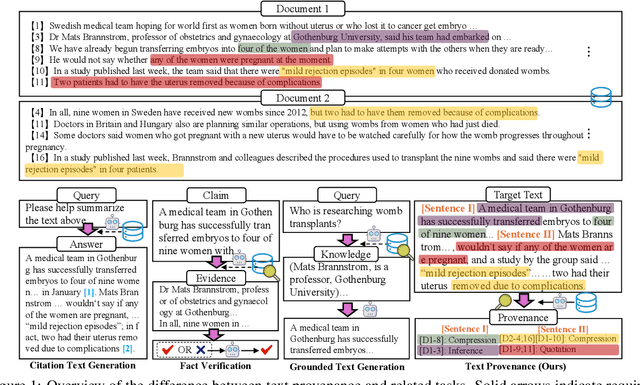
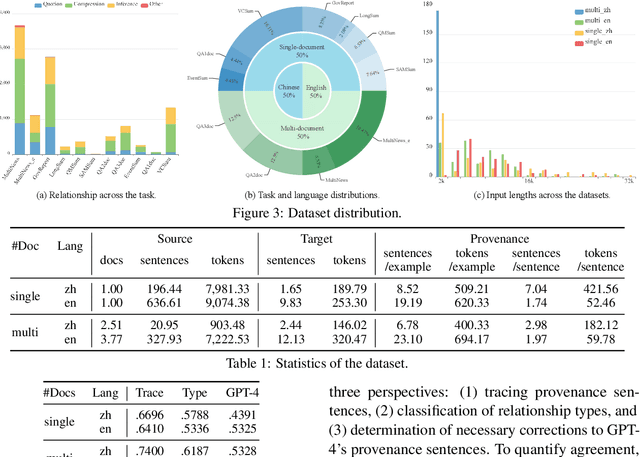

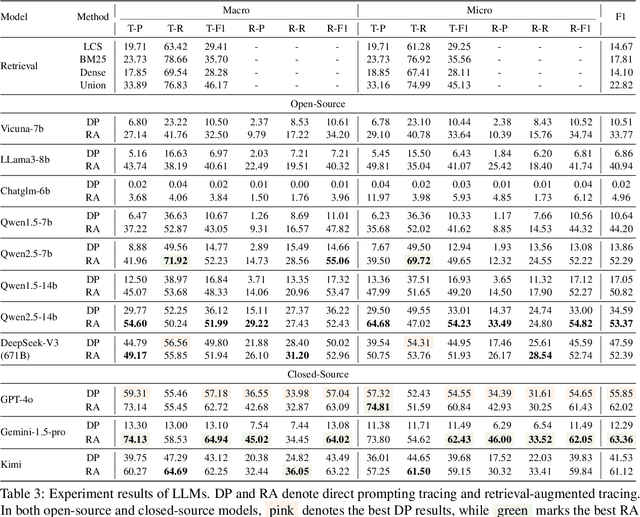
Abstract:LLMs have achieved remarkable fluency and coherence in text generation, yet their widespread adoption has raised concerns about content reliability and accountability. In high-stakes domains such as healthcare, law, and news, it is crucial to understand where and how the content is created. To address this, we introduce the Text pROVEnance (TROVE) challenge, designed to trace each sentence of a target text back to specific source sentences within potentially lengthy or multi-document inputs. Beyond identifying sources, TROVE annotates the fine-grained relationships (quotation, compression, inference, and others), providing a deep understanding of how each target sentence is formed. To benchmark TROVE, we construct our dataset by leveraging three public datasets covering 11 diverse scenarios (e.g., QA and summarization) in English and Chinese, spanning source texts of varying lengths (0-5k, 5-10k, 10k+), emphasizing the multi-document and long-document settings essential for provenance. To ensure high-quality data, we employ a three-stage annotation process: sentence retrieval, GPT provenance, and human provenance. We evaluate 11 LLMs under direct prompting and retrieval-augmented paradigms, revealing that retrieval is essential for robust performance, larger models perform better in complex relationship classification, and closed-source models often lead, yet open-source models show significant promise, particularly with retrieval augmentation.
Multi-Stage Pre-training Enhanced by ChatGPT for Multi-Scenario Multi-Domain Dialogue Summarization
Oct 16, 2023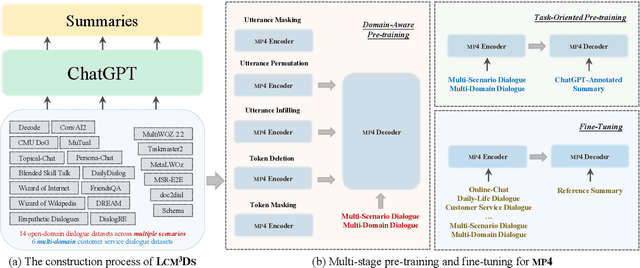


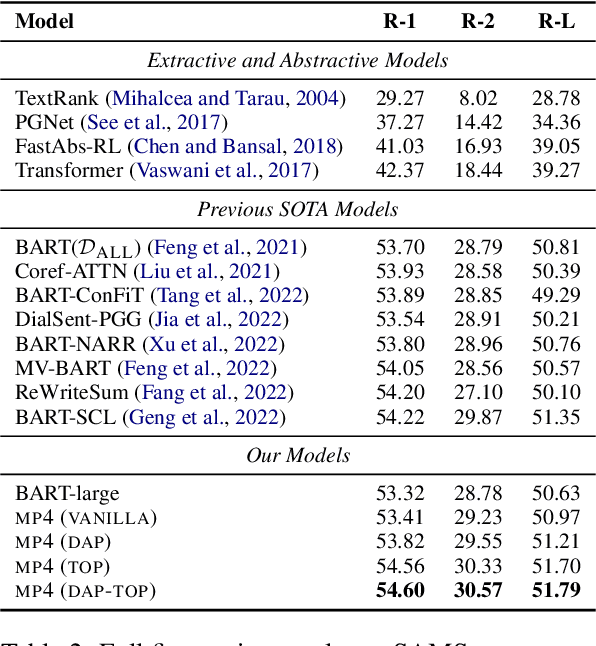
Abstract:Dialogue summarization involves a wide range of scenarios and domains. However, existing methods generally only apply to specific scenarios or domains. In this study, we propose a new pre-trained model specifically designed for multi-scenario multi-domain dialogue summarization. It adopts a multi-stage pre-training strategy to reduce the gap between the pre-training objective and fine-tuning objective. Specifically, we first conduct domain-aware pre-training using large-scale multi-scenario multi-domain dialogue data to enhance the adaptability of our pre-trained model. Then, we conduct task-oriented pre-training using large-scale multi-scenario multi-domain "dialogue-summary" parallel data annotated by ChatGPT to enhance the dialogue summarization ability of our pre-trained model. Experimental results on three dialogue summarization datasets from different scenarios and domains indicate that our pre-trained model significantly outperforms previous state-of-the-art models in full fine-tuning, zero-shot, and few-shot settings.
Life-long Learning for Multilingual Neural Machine Translation with Knowledge Distillation
Dec 06, 2022
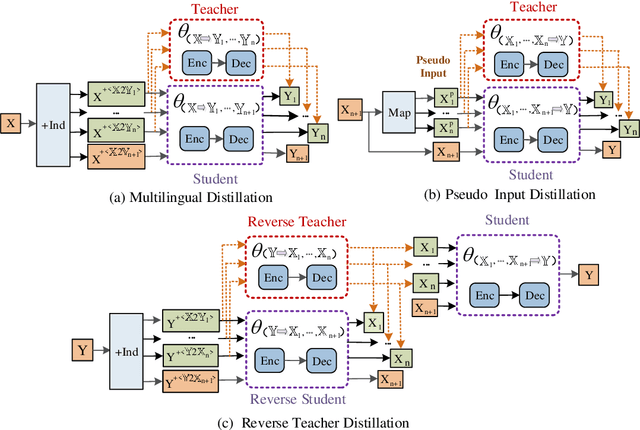
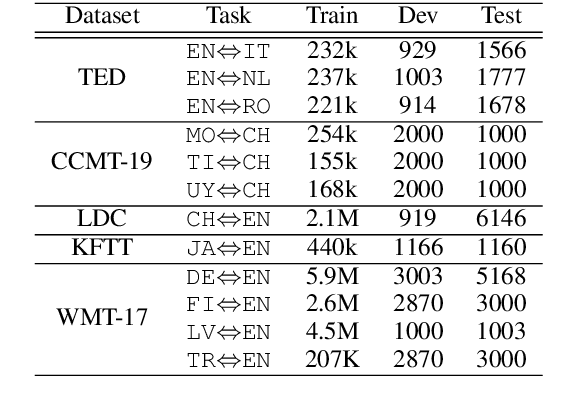
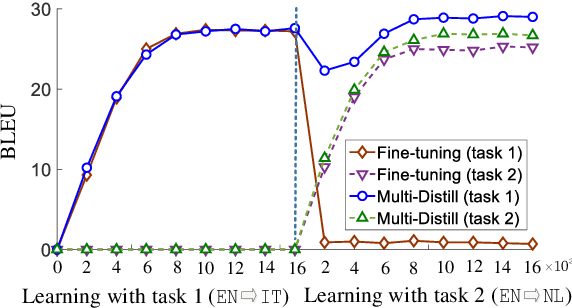
Abstract:A common scenario of Multilingual Neural Machine Translation (MNMT) is that each translation task arrives in a sequential manner, and the training data of previous tasks is unavailable. In this scenario, the current methods suffer heavily from catastrophic forgetting (CF). To alleviate the CF, we investigate knowledge distillation based life-long learning methods. Specifically, in one-tomany scenario, we propose a multilingual distillation method to make the new model (student) jointly learn multilingual output from old model (teacher) and new task. In many-to one scenario, we find that direct distillation faces the extreme partial distillation problem, and we propose two different methods to address it: pseudo input distillation and reverse teacher distillation. The experimental results on twelve translation tasks show that the proposed methods can better consolidate the previous knowledge and sharply alleviate the CF.
Neural Models for Sequence Chunking
Jan 15, 2017


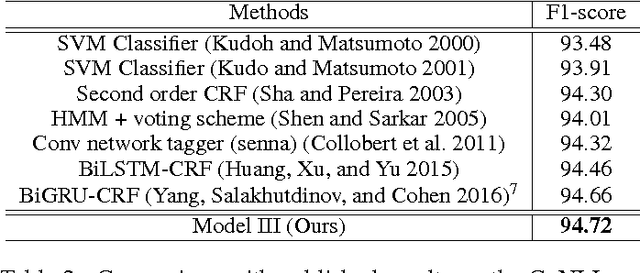
Abstract:Many natural language understanding (NLU) tasks, such as shallow parsing (i.e., text chunking) and semantic slot filling, require the assignment of representative labels to the meaningful chunks in a sentence. Most of the current deep neural network (DNN) based methods consider these tasks as a sequence labeling problem, in which a word, rather than a chunk, is treated as the basic unit for labeling. These chunks are then inferred by the standard IOB (Inside-Outside-Beginning) labels. In this paper, we propose an alternative approach by investigating the use of DNN for sequence chunking, and propose three neural models so that each chunk can be treated as a complete unit for labeling. Experimental results show that the proposed neural sequence chunking models can achieve start-of-the-art performance on both the text chunking and slot filling tasks.
SummaRuNNer: A Recurrent Neural Network based Sequence Model for Extractive Summarization of Documents
Nov 14, 2016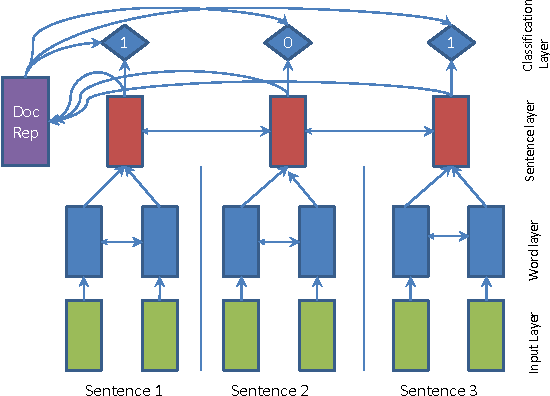

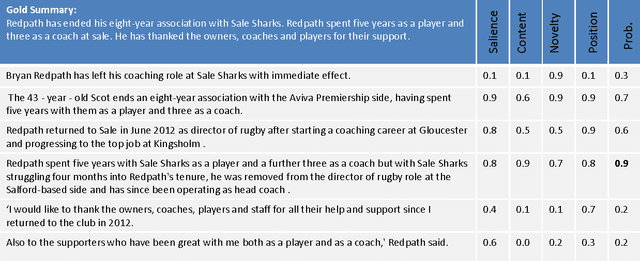

Abstract:We present SummaRuNNer, a Recurrent Neural Network (RNN) based sequence model for extractive summarization of documents and show that it achieves performance better than or comparable to state-of-the-art. Our model has the additional advantage of being very interpretable, since it allows visualization of its predictions broken up by abstract features such as information content, salience and novelty. Another novel contribution of our work is abstractive training of our extractive model that can train on human generated reference summaries alone, eliminating the need for sentence-level extractive labels.
 Add to Chrome
Add to Chrome Add to Firefox
Add to Firefox Add to Edge
Add to Edge